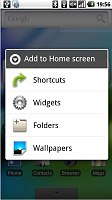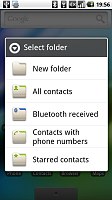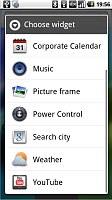Motorola MILESTONE review: Hello Droid
Hello Droid
Android turns 2
The Android OS is no longer breaking news but the Motorola MILESTONE is the first device to ship with the latest 2.0 version. So, it has a great chance to offer quite a few software advantages over its market rivals. The 2.0 update will eventually make its way to more devices of course but time works in the MILESTONE's favor right now.
The new version of the "Google OS" brings many new features and a whole new set of APIs to allow even more useful apps to flood the Google Market. The web browser and the camera have been updated, along with the messaging department, the phonebook, calendar and the virtual keyboard.
However, the general user interface hasn't undergone any major changes. The MotoBLUR interface that was developed for the Motorola CLIQ (or DEXT if you prefer) is nowhere to be seen on our unit but it will perhaps be ported via a software update.



Android 2.0 brings some new features but the interface is basically the same
The homescreen is the cornerstone of the Android UI. Giving you three screen panes worth of space (by default), it helps you put up front all the items you need most and use most frequently. And there are plenty of things that can go up there. You have shortcuts to applications of your choice, then folders and, finally, widgets.



Some of the homescreen inhabitants: widgets and folders
Folders can help you keep the shortcuts organized but you can't put folders within folders. Still, they can be used for a few quick tricks – like faking a quick-dial contact list. A contact's photo serves as a dial shortcut so all you have to do is put a bunch of them in a folder.
But there’s nothing too special about that – it's when live folders come into play that it gets exciting. The main difference to ordinary folders is that the live folders are automatically filled with content.
All sorts of lists can go into Live folders. For example, you can have a folder that contains all the tweets from a contact, or an RSS feed, or maybe even a folder with all the good restaurants within walking distance from a given location. The preinstalled Live folders are "Contacts with phone numbers" and "Starred contacts". Naturally, they are filled with your Gmail contacts that either have phone numbers or are starred.
The other inhabitants of the Android homescreen are the widgets. There are three new preinstalled widgets that come with the Android v2.0 - a corporate calendar (the one synced with your Exchange account), the Weather widget and the Power control widget (a handy connectivity manger for your desktop). The power control was known as Switchers on the Galaxy so it's not really new but they added a display backlighting control to it so it counts here.
The traditional search widget got an update too and now shows suggestions as you type, just like the Google homepage. It searches local files or gives you a shortcut to initiate a web search, which is a really neat solution. You can also make use of voice searches just like with Google's iPhone app.
In case the default homescreen is not much to your liking there are already several alternatives available at the Google Market. They each give you a few different organizing options and a bigger number of screens.
A major advantage of Android is the notification area. It's a thin bar at the top of the screen with status info about battery, signal strength and others such as Bluetooth or missed events.But if you slide it down you get a list of all recent notifications - that's the so called notifications area. Tapping on one of the listed notifications takes a context relevant action - for instance, a tap on a notification of a successful installation would launch that application; a finished download notification will open the file and so on.

The notification area is one of Android's key assets
Since you can open the notification area from wherever the top bar is visible, new events won't interrupt your work. You can pull the tray down like a window blind just enough to see more details about what has happened and if it doesn't need your immediate attention you can let it roll back up and continue where you left off.
To bring up the task switcher on the MILESTONE you can press and hold the Home key just like on any other Android phone. The "task switcher" is not really a task switcher, nor is it a task manager. In fact, Android automatically opens and closes applications. When resources start to run out, it might close a currently inactive app but it will restore it back to just how you left it. It's more like the system puts the app to hibernation instead of closing it. Still, the task switcher is useful as it gives you access to the six most recently used apps.

The Android task switcher has shortcuts to the six most recently used apps
Already feeling quite snappy on the 528 MHz Qualcomm CPUs, Android works like a charm on the Cortex-A8 processor of the MILESTONE. The developers did a really good job of solving the performance issues on all devices since ver. 1.5 but now that they have more powerful hardware at hand, things feel even better.
We have prepared a short video demo of the Motorola MILESTONE so you can see that for yourselves.
Well-equipped phonebook
The phonebook can store quite a lot of information. It lets you input numbers for work and home, and you can even create custom labels. There is of course an email field and you can assign a custom ringtone.

The MILESTONE phonebook is pretty good
Android 2.0 has introduced support for quick contacts. That means you can put a contact photo in the phonebook and use it to call, text, or email the person with a single click.


The quick contacts brought by Android 2.0 are quite convenient
Another upgrade brought by the new version is the support for multiple accounts for email and contact synchronization, including Exchange accounts.
You can add an IM nickname to the contact as well as a postal address, company and job title, several notes, you name it. Quite interesting is the option to redirect calls directly to voicemail.
There are many info fields that you can assign to each contact, but it still remains perfectly organized. You have all the types listed (numbers, email addresses, etc) and there's a plus sign on the right - clicking it adds another item of that type. Pressing the minus sign under it deletes the unneeded field.
When viewing a contact the various details are displayed in sections. There is a Dial number and a Send SMS/MMS tab with the numbers for the contact listed. Each number fills an entire horizontal row so that it's more thumbable.
Email also has a dedicated tab that works just like the one for numbers. The rest of the information (if any) is displayed underneath.
You can "star" a contact, which puts it in the Favorites tab. Also, in each Gmail account there's a special group called "Starred in Android" where these contacts go automatically.
Adding a photo to a contact is quite easy: when you select a photo, a cropping tool comes up allowing you to use any part of the image you want. Adding a photo has another pleasing "side effect" - if you put a dialing shortcut for the contact on the screen, it uses the photo as an icon.
Searching for a contact in the phonebook is quite easy - just hit the search key and a search box pops up.
Reader comments
- PLAYER SLAYER
- 12 Dec 2016
- r2j
"The mandatory - for the Android breed - microSD memory card is 8GB, which is probably more than most users will ever need." I felt this to be funny, so I'm reposting it for your entertainment
- Komli
- 04 Apr 2013
- IjG
Your's is the intelligent apporach to this issue.
- Jany
- 14 Feb 2013
- mMq
About sound quality, i used some good headphones on it, i compared it to Soundblaster X-Fi HD, and i must say, this device has VERY GOOD sound, i tested lot of phones, most of them have crap output. Bass control is great, you give more bass, and it d...



